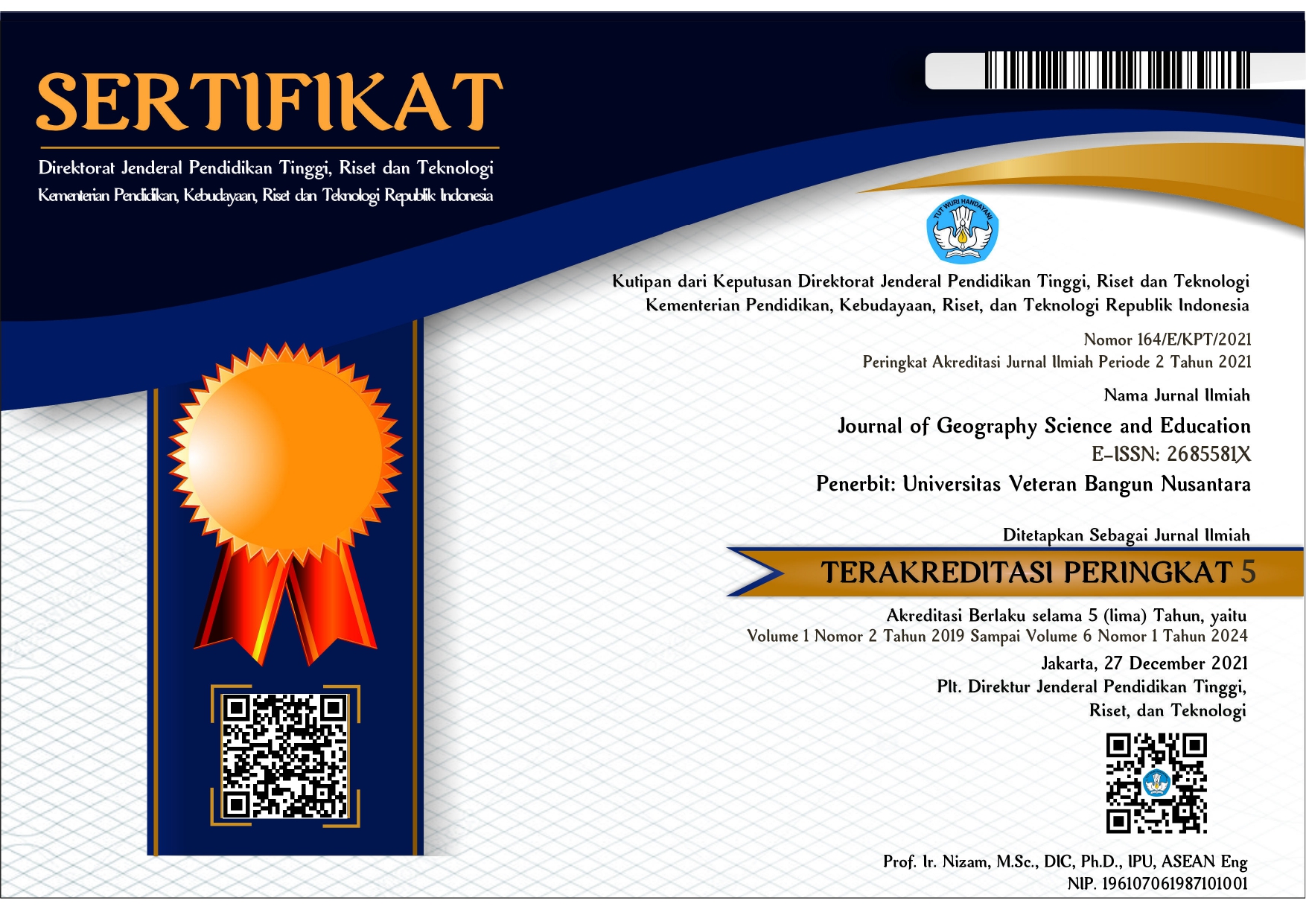MAPPING VOTES for VOTING GENERAL ELECTIONS MEMBERS of THE HOUSE REPRESENTATIVES, and REGIONAL HOUSE REPRESENTATIVES in SUKOHARJO SUB-DISTRICT, SUKOHARJO DICTRICT 2019
DOI:
https://doi.org/10.32585/jgse.v1i2.467Abstrak
This research aims to distribution of general voting pleaces member of the house of representative and regional people’s representative asembly on sukoharjo sub-district and sound calculation results political parties general election participants member of the house of representative and regional people’s representative assembly every pleace of voting votes in Sukoharjo sub-districtSukoharjo district’s. This report uses quantitative descritive that is disclosure and know the location point spreads
of general election places members of the house of representative and regional people’s representative assembly 2019. And resuilts of sound calculations every political party every place voting around sukoharjo sub-district, data colection techniques used are are through direct observation in te field, and documentation data analysis techniques used are analysis of table and data map. This research results are spreadd of spot vocational places in sukoharjo sub-district. There are 252 sound vocational places spreads in 14 areas set by the commission of general elections accordingto many population in every way, the most amount of the most vocational place is Sukoharjo cheap and Gayam cheap each with 27 sound vocational place, and the little area of number of sound votes Combongan cheap with 13 sound vocation place general election member of the house of representative, in the level of the people’s representative of the republic of indo the provincial people’s representativf council and the district representative concil in the sukoharjo sub-district dominated by PDIP parties
Keywords: distribution, voting place house of representative, regional people’s representatif assembly, Party
Unduhan
Referensi
Andi. 2005. Sistem Informasi Geografi dengan AutoCAD MAP. Yogyakarta: Wahana Komputer Semarang.
Aryono Prihandito, 1989, “Kartografi”, Mitra Gama Widya, Yogyakarta.
Bintarto, R dan Surattopo Hadi Sumarmo. 1987. Metode Analisa Geografi. Jakarta:LP3ES.
Budiardjo, Miriam. 2013. Dasar-Dasar Ilmu Politik. Jakarta: PT Gramedia Pustaka Utama.
Gaffar, Janedjri M. 2013. Demokrasi Dan Pemilu Di Indonesia. Jakarta: Konstitusi Press (KONPRESS).
Juhadi, dan Dewi Liesnoor S. 2001. Desain dan Komposisi Peta Tematik. Semarang: CV.Indoprint.
Kuswanto, Eko. 2018. Pemetaan Fasilitas Kesehatan Badan Penyelengara Jaminan Sosial Kesehatan Kecamata Sukoharjo Kabupaten Sukoharjo. Skripsi.Univet Bantara Sukoharjo.
Marfai, Aris. 2015. Pemodelan Geografi. Yogyakarta: Ombak.
Moleong, Lexy J. 2012. Metode Penelitian Kualitatif. Bandung: PT Remaja Rosdakarya.
NN. 2004. Kumpulan Undang-Undang Bidang Politik. Surakarta: PT Pabelan Surakarta.
Rafiani, Minda. 2018. Jangkauan Pemasaran Home Industri Intip Desa Jati Kecamatan Sumberlawang Kabupaten Sragen Tahun 2018 . Skripsi.Univet Bantara Sukoharjo
Setyowati, Dewi Liesnoor dkk. 2014. Kartografi Dasar. Yogyakarta: Ombak.
Soekidjo. 1994. Pengembangan Potensi Wilayah. Bandung. Gramedia
Unduhan
Diterbitkan
Cara Mengutip
Terbitan
Bagian
Lisensi
License and Copyright Agreement
In submitting the manuscript to the journal, the authors certify that:
- They are authorized by their co-authors to enter into these arrangements.
- The work described has not been formally published before, except in the form of an abstract or as part of a published lecture, review, thesis, or overlay journal. Please also carefully read JGSE's Posting Your Article Policy at http://pubs2.ascee.org/index.php/ijele/about/editorialPolicies#custom-5
- That it is not under consideration for publication elsewhere,
- That its publication has been approved by all the author(s) and by the responsible authorities – tacitly or explicitly – of the institutes where the work has been carried out.
- They secure the right to reproduce any material that has already been published or copyrighted elsewhere.
- They agree to the following license and copyright agreement.
Copyright
Authors who publish with Journal of Geography Science and Education agree to the following terms:
- Authors retain copyright and grant the journal right of first publication with the work simultaneously licensed under a Creative Commons Attribution License (CC BY-SA 4.0) that allows others to share the work with an acknowledgment of the work's authorship and initial publication in this journal.
- Authors are able to enter into separate, additional contractual arrangements for the non-exclusive distribution of the journal's published version of the work (e.g., post it to an institutional repository or publish it in a book), with an acknowledgment of its initial publication in this journal.
- Authors are permitted and encouraged to post their work online (e.g., in institutional repositories or on their website) prior to and during the submission process, as it can lead to productive exchanges, as well as earlier and greater citation of published work.
Licensing for Data Publication
Journal of Geography Science and Education use a variety of waivers and licenses, that are specifically designed for and appropriate for the treatment of data:
- Open Data Commons Attribution License, http://www.opendatacommons.org/licenses/by/1.0/ (default)
- Creative Commons CC-Zero Waiver, http://creativecommons.org/publicdomain/zero/1.0/
- Open Data Commons Public Domain Dedication and Licence, http://www.opendatacommons.org/licenses/pddl/1-0/
Other data publishing licenses may be allowed as exceptions (subject to approval by the editor on a case-by-case basis) and should be justified with a written statement from the author, which will be published with the article.
Open Data and Software Publishing and Sharing
The journal strives to maximize the replicability of the research published in it. Authors are thus required to share all data, code or protocols underlying the research reported in their articles. Exceptions are permitted but have to be justified in a written public statement accompanying the article.
The associated persistent identifiers (e.g. DOI, or others) of the dataset(s) must be included in the data or software resources section of the article. Reference(s) to datasets and software should also be included in the reference list of the article with DOIs (where available). Where no domain-specific data repository exists, authors should deposit their datasets in a general repository such as ZENODO, Dryad, Dataverse, or others.
Small data may also be published as data files or packages supplementary to a research article, however, the authors should prefer in all cases a deposition in data repositories.










